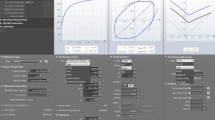The effect of the as-received condition of an aluminum alloy on its stampability in the production of an automobile part is examined. An explanation is given of the process of using software package PAM-STAMP to model the sheet-stamping operation. The results obtained from the modeling clearly show the need to correctly choose not only the material that will be used to make the part but also the properties that it will have as a result of the condition in which it is received.





Similar content being viewed by others
References
B. N. Matveev, “New types of materials and semifinished products for the automobile industry (survey of the foreign and domestic literature),” Zagotov. Proizv. Mashinostr., No. 6, 47–52 (2007).
I. N. Fridlyander, V. G. Sister, O. E. Grushko, et al, “Aluminum alloys – promising materials for the automobile industry,” MiTOM, No. 9, 3–9 (2002).
S. Holmberg and P. Thilderkvist, “Influence of material properties and stamping conditions on the stiffness and static dent resistance of automotive panels,” Materials & Design, 23, No. 8, 681–691 (2002).
Yu. N. Loginov, B. I. Kamenetskii, and G. I. Studenok, “Modeling the strain state of a circular sheet during drawing,” Izv. Vyssh. Uchebn. Zaved. Chern. Metall., No. 3, 26–28 (2006).
I. A. Choudhury, O. H. Lai, and L. T. Wong, “PAM-STAMP in the simulation of stamping process of an automotive component,” Simul. Model.: Pract. & Theory, 14, No. 1, 71–81 (2006).
A. A. Ershov and Yu. N. Loginov, “Using the inverse solver INVERSE in PAM-STAMP 2G to assess the formability of a part,” Metallurgist, 57, No. 5/6, 372–377 (2013).
Yu. N. Loginov and A. A. Ershov, “Using the software QFORM to model the formation of a pull crack during pressing,” Kuzn.-Shtamp. Proizv. Obrab. Mater. Davl., No. 7, 42–46 (2013).
Yu. N. Loginov and A. A. Ershov, “Effect of the form of the strain-hardening curve on local deformation during the upsetting of titanium semifinished products,” Titan, No. 1, 22–28 (2012).
M. S. Mohamed, A. D. Foster, J. Lin, et al., “Investigation of deformation and failure features in hot stamping of AA6082: experimentation and modeling,” Int. J. Mach. Tools & Manuf., 53, 27–38 (2012).
O. Fahrettin, E. Emre, T. Serkan, and R. P. Catalin, “Effects of aging parameters on formability of 6061-O alloy,” Materials and Design, 31, 4847–4852 (2010).
N. Abedrabbo, F. Pourboghrat, and J. Carsley, “Forming of AA5182-O and AA554-O at elevated temperatures using coupled thermo-mechanical finite element models,” Int. J. Plasticity, 23, 841–875 (2007).
S. K. Hong, K. Muammer, and N. Jun, “Development of an analytical model for warm deep drawing of aluminum alloys,” J. Mater. Proc. Technol., 197, 393–407 (2008).
A. A. Ershov, V. V. Kotov, and Yu. N. Loginov, “Calculation of the compensation of a stamping tool after springback in the software package PAM-STAMP 2G,” Metallurgist, 56, No. 7/8, 477–481 (2012).
A. A. Yershov, V. V. Kotov, and Yu. N. Loginov, “Optimization of the initial form of a semifinished product in PAM-STAMP 2G,” Metallurgist, 56, No. 3/4, 231–235 (2012).
H. Halim, D. S. Wilkinson, and M. Niewczas, “The Portevin–Le Chatelier (PLC) effect and shear band formation in an AA5754 alloy,” Acta Mater., 55, 4151–4160 (2007).
Author information
Authors and Affiliations
Corresponding author
Additional information
Translated from Metallurg, No. 3, pp. 38–41, March, 2014.
Rights and permissions
About this article
Cite this article
Ershov, A.A., Loginov, Y.N. Use of the Program PAM-STAMP to Study the Effect of the As-Received Condition of a Material on its Formability During Stamping. Metallurgist 58, 162–166 (2014). https://doi.org/10.1007/s11015-014-9886-2
Received:
Published:
Issue Date:
DOI: https://doi.org/10.1007/s11015-014-9886-2




